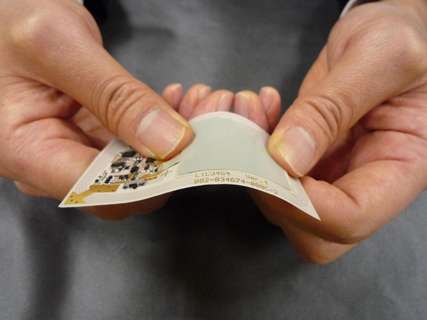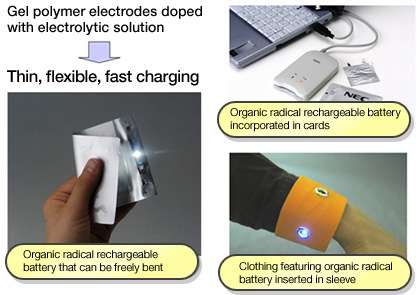March 18, 2012 report
NEC goes ultra-thin with 0.3mm-thick batteries

(PhysOrg.com) -- NEC, which has been working on what is called "organic radical battery" (ORB) technology for some years, has announced its latest ORB breakthrough, the 0.3mm thick ORB. According to Geek.com, the output rated as 5kW/L with a capacity of 3mAh. On full charge, the new battery prototype can refresh a screen 2,000 times. A recharge takes under a minute, about 30 seconds. The new batteries maintain 75 percent of their charge-discharge after 500 charges.
NEC has been exploring these polymer-based batteries since 2001, but the battery thickness was limited to 0.7mm. The new battery was made using printing technologies to integrate circuit boards with batteries, whereby negative electrodes were embedded directly on to the circuit boards. This presents important possibilities in applications, especially for use in what is being called "enhanced" credit and debit cards. Up to now, the ORBs of 0.7mm thickness were a difficult hurdle for standard integrated circuit (IC) cards, according to reports.
The battery is now compatible with these cards, the types that may serve as credit cards, subway and train passes, or as hotel door-keys. Standard-size smartcards equipped with a battery would be an attractive use of the new ORBs. Consumers, for example, could avoid ATMs when wanting to check out their bank balance. They could enjoy the convenience of checking out the information on a tiny screen on the card.
The envisioned ultra-thin, flexible plastic credit cards may not appear commercially this year but reports say that NEC intends to have ORB incorporated in products in 2013.
According to Gizmodo, NEC envisions these new-generation batteries, beyond credit cards, in flat screen displays and in flexible e-readers that feel like paper.

A simple and brief explanation of its technology appears on the NEC site: The wording similarly indicates NEC’s vision of ORB technologies put to commercial use.
“NEC conducts research and development of thin and highly flexible rechargeable batteries that can be incorporated in ubiquitous terminals such as IC cards, RF tags, and electronic paper.”
The site adds that the “organic radical battery developed by NEC uses a flexible gel polymer for the electrodes that enables the creation of thin batteries that can be bent freely. Such batteries, which also have the advantage of being rechargeable in less than one minute, are expected to be used in a variety of fields.”
NEC says that still another end use of the ORBs might be in the form of ORBS directly on clothing, NEC shows an illustration where the battery is inserted in the sleeve.
More information: www.nec.co.jp/rd/en/green/energy.html , www.nec.co.jp/press/ja/1203/0504.html (in Japanese)
© 2011 PhysOrg.com


















